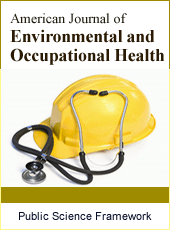American Journal of Environmental and Occupational Health
Articles Information
American Journal of Environmental and Occupational Health, Vol.1, No.1, Sep. 2016, Pub. Date: Sep. 3, 2016
Nature of Students’ Sexual Abuse
Pages: 20-26 Views: 3957 Downloads: 843
[01]
Isaac Eshun, Department of Arts and Social Sciences, Enchi College of Education, Enchi, Ghana.
[02]
Anthony Bordoh, Department of Arts and Social Sciences, Enchi College of Education, Enchi, Ghana.
[03]
Patrick Kwarteng, Department of Arts and Social Sciences, Wiawso College of Education, Sefwi Wiawso, Ghana.
[04]
Shani Osman, Department of Arts and Social Sciences, Tumu College of Education, Tumu, Ghana.
[05]
Kweku Joseph Prah, Social Sciences Department, Kwegyir Aggrey Senior High School, Anomabo, Ghana.
Student sexual abuse is a reality in our senior high schools and the nature of it is on the rise. To find how grievous sexual abuse in senior high schools is, the study examined the nature of sexual abuse in public senior high schools. The research was conducted in four (4) different public senior high schools in the Mfantsiman Municipality in the Central Region of Ghana as one case study. Simple size of 403 students and 20 teachers as participants were employed for the study, simple random sampling and purposive sampling techniques were used to select the respondents. Structured questionnaires were used to solicit data from the respondents. The data were presented in the form of percentages and frequency tables to facilitate clearer and easier interpretation of results for the presentation of findings. The varying nature of sexual abuse from the respondents for the study indicated that penetrative form of sex may include unwanted oral sex, anal or vaginal intercourse were admitted by the students and teachers as well as non-contact sexual abuse which may include, sexual harassment, unwanted sexual phone calls, unwanted sexual messages, unwanted sexual jokes and frequent request for sexual favours are common in public senior high schools in Ghana. Perhaps, today, our senior high schools present a prime target for perpetrators of sexual abuse because most schools have few, if any protective barriers in place. Strategies like continued examination of counselling services in public senior high schools to give advice on sexual maturation and concerns such as assault, sexual harassment and teenage pregnancy should be provided to female students. Necessary provisions should be made for female students with special needs so that they can care for themselves and become productive resources for the society.
Nature, Abuse, Sexual Abuse, Students, Senior High Schools
[01]
Alberta Civil Liberties Research Centre (1997). Sexual harassment in school: Your rights and responsibilities. Calgary: Alberta Law Foundation.
[02]
Arjun, P. A. (1992). Sexual harassment: A guide for understanding and prevention. Toronto: Butterworth.
[03]
Basile, K. C. & Saltzman, L. E. (2002). Sexual violence surveillance: Uniform definition and recommendation data elements. Atlanta, GA: National Centre for injury prevention and control centres for diseases control and prevention.
[04]
Bouchard, E. (1994). Everything you need to know about sexual harassment. New York: The Rosen Publishing Group.
[05]
Castle, S. & Diallo, V. (2008). Desk review of evidence about violence within educational settings in West and Central Africa. Lome: Action Aid and UNICEF.
[06]
Dev. Tech Systems Inc and Centre for Educational Research and Training (2007). The safe schools programme student and teacher baseline report on school-related gender-based violence in Machinga District, Malawi. USAID. Issued December 2007. Retrieved: 5/9/2015.www.pdf.usaid.gov/pdf docs/PNADK758
[07]
Gall, M. D., Gall, J. P., & Borg, W. R. (2007). Educational research: An introduction. Boston: Pearson Education.
[08]
Ghana Education Service (2000). Conditions and scheme of service and the code of professional conduct for teachers. Accra Ghana: Ghana Education Service.
[09]
Ghana Police Service (2008). Annual report: Domestic Violence Victims Support Unit, Ghana Police Service. Child Research and Resources Centre. Report on the study of child sexual abuse in schools. Accra, Ghana: Plan Ghana.
[10]
Jones, D. P. H. & Ranchandari, P. (1999). Child sexual abuse. Radcliffe Publishing: Oxford.
[11]
Lalor, K. (2004). Child sexual abuse in Sub-Saharan Africa: A literature review, child abuse and neglect. World Health Organization, Regional Office, USAID. 286, 439-460.
[12]
Merril, D. (2004). Encyclopaedia of rape (1st Ed). Westport: Greenwood Press.
[13]
Republic of Ghana (1992). The Constitution of the Republic of Ghana. Government of Ghana. Accra: Government of Ghana.
[14]
Richter, L. & Higson-Smith, C. (2004). The many kids of sexual abuse of young children. In L. Richter., A. Dawes., & C. Higson-Smith (Eds). Sexual abuse of young children in South Africa. Cape Town: HSRC Press.
[15]
Shakeshaft, C. & Cohan, A. (1995). Sexual abuse of students by school personnel. Phi Delta kappan. 76(7), 512-520.
[16]
Stavropoulos, J. (2006). Violence against girls in Africa: A retrospective survey in Ethiopia, Kenya and Uganda. Addis Ababa: Africa child policy forum. Retrieved: 20/10/ 2015, from www.africanchildforum.org.
[17]
Taylor, R. & Conrad, S. (2008). Break the silence: Prevent sexual exploitation and abuse in and around schools in Africa. Dakar: Plan West Africa.

ISSN Print: Pending
ISSN Online: Pending
Current Issue:
Vol. 2, Issue 2, March Submit a Manuscript Join Editorial Board Join Reviewer Team
ISSN Online: Pending
Current Issue:
Vol. 2, Issue 2, March Submit a Manuscript Join Editorial Board Join Reviewer Team
| About This Journal |
| All Issues |
| Open Access |
| Indexing |
| Payment Information |
| Author Guidelines |
| Review Process |
| Publication Ethics |
| Editorial Board |
| Peer Reviewers |


